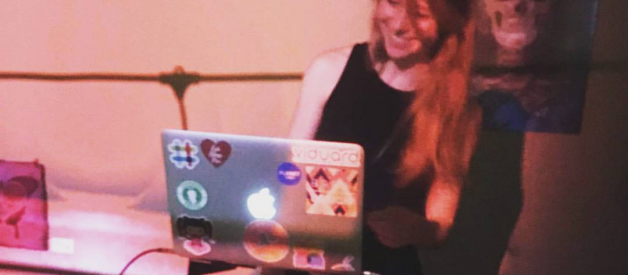When I first started mixing, I googled ?How to DJ? where I was welcomed with a disappointing handful of guides. They used terms I had never heard of, explained techniques, skills I didn?t know I needed and seemed to be targeted at someone who already had some foundation. It lead me to consider doing an audio engineering course on Coursera (which is totally not necessary at this stage) while reading How-To Wikis. Frankly, I was all over the place. Coming out of the tech space where (almost) everything is meticulously documented, this was a surprise to me.
I?m writing this not because I know everything there is to know about mixing. Instead, I am writing this in dire urgency because I?m finally starting to understand something about mixing music. In order to write a useful beginner how-to piece, one has to remember every little thing they did not know when they were starting out. So, logically, only a beginner can write a beginner piece with enough empathy to cover everything in agonizing detail. Here I will walk you through the things I have learned (read: stumbled across by luck and overwhelmingly battled through trial and error) between the first day of deciding I wanted to DJ to playing my first gig at The Royale in San Francisco with hundreds of people, 8 months later.
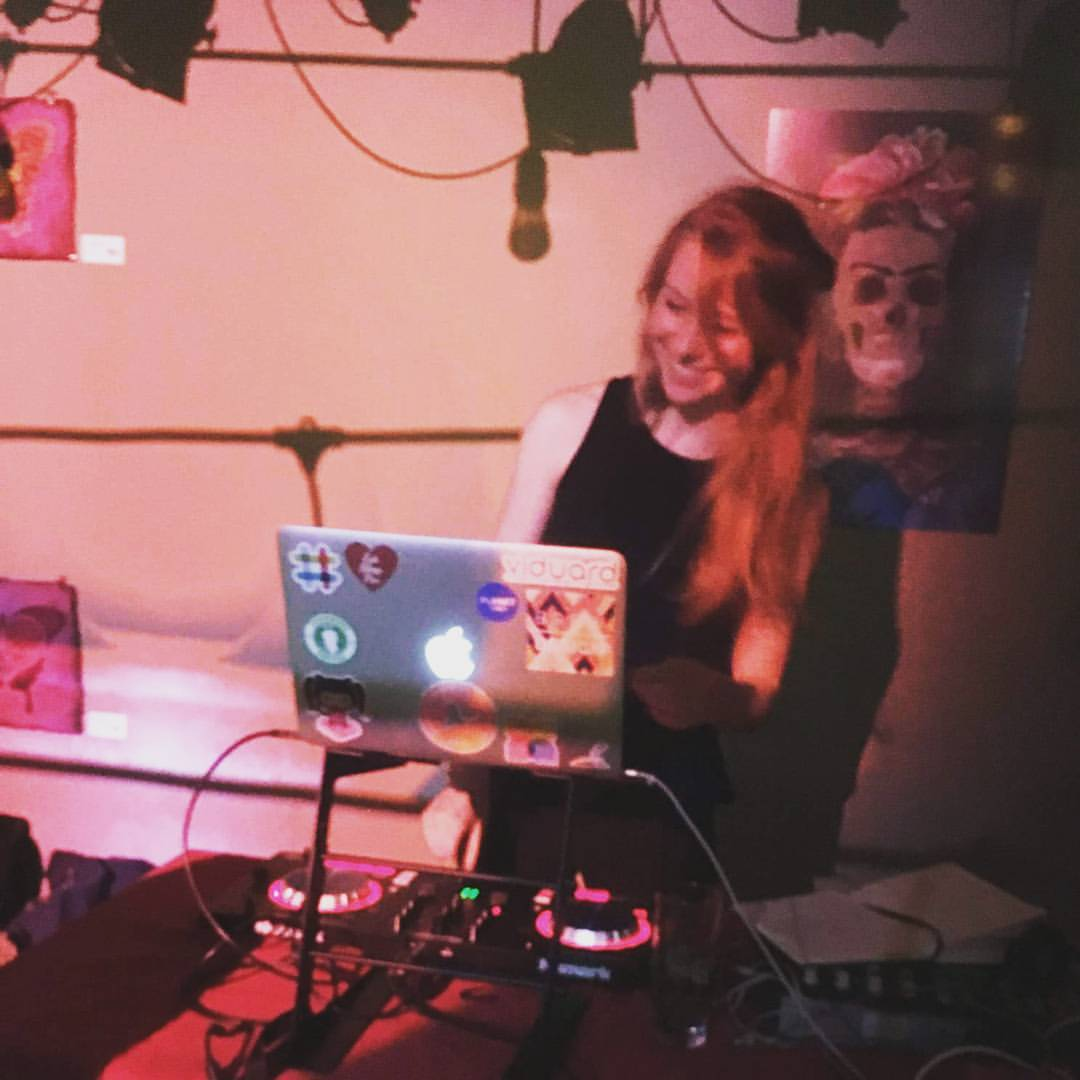 Playing DOLOFEST
Playing DOLOFEST
While we?re going into agonizing detail, it is worth explaining what DJing and mixing music actually entails. For this, nothing beats an example.
DJing is taking a collection of songs that fit together by a number of qualities and finding a way to mix them together at key moments to keep people dancing on the dance floor, while augmenting songs? enchanting qualities. My mom likes to call it ?compiling?.
2) Production vs. Mixing Software
When you enter this space and begin to familiarize yourself with mixing, you will find that the easiest way to get started is with the help of software. You can definitely mix exclusively off vinyl, avoiding software and its perks, but as a beginner, a software-aided path allows you to learn as much as possible in a short amount of time with limited financial investment.
When considering software, I learned that mixing software will fall into one of two categories: production software and mixing software. Production software usually refers to a tool that you use to make new songs yourself. It includes a selection of drums, piano, bass, and optimizes for short pieces. Mixing software gives you a user interface to evaluate the BPM, key, and measures of two songs and best coerce them together.
When starting out, I started using Ableton Live, which happens to be production software. I spent almost 4 months in barren desert-lands learning to count the BPMs of songs and manually evaluate the key of songs. This is not to say that Ableton Live cannot be used for mixing ? some of the best DJs do (Andrew, Flume, Alison Wonderland), but it is devoid of helpful tools that can help you pick up DJing a lot faster.
3) Types of Software, Pros and Cons
Production SoftwareAbleton Live ? used by Alison Wonderland, Kanye, and other mainstream artists. An entirely different approach to mixing which involves sampling a lot of tracks, also involves different hardware tools than normal mixing software uses. It is not exclusively production software ? it is also intended for live performances, hence Ableton Live.
Mixing SoftwareTraktor ? An industry standard, one of the ?giants?, majority of DJs use this, often sold along with hardware controllers so you can buy a controller bundled with software and save a bit of money. The controller you buy will be perfectly mapped to your software as well. Serato ? The other industry standard, the other ?giant?, a direct competitor to Traktor. People say that Serato has a better interface but Traktor has more features.Virtual DJ ? Very similar to Serato, and has a nice feature which will automatically find you compatible songs by Key and BPM to make curating a bit easier.Mixxx (on Mac) ? Free, open source mixing software. You can download it to see what kinds of features mixing software has.Djay Pro by Algoriddm? Has Spotify integration which is a massive plus ? you can play around with literally any song you can favourite on Spotify (requires Spotify premium). It is perfect for someone who is learning since it means you do not have to put in the time to download all the music you might want to play up front. HOWEVER, you cannot record mixes while playing songs with Spotify, you have to download/buy your own music to actually do the recording.
I found that Spotify integration outweighed any other pros of software I could possibly consider. This may change, but as a beginner this was what I needed most. As a result I use Djay Pro. It has beautiful, seamless integration for Mac, has abstractified most complexities (but allows you to introduce them once you?re ready) and also doesn?t tie you to specific controllers.
4) Introduction to Beat Matching
In order to mix two songs, the first step is to match the two BPMs of the songs.
When selecting two songs to mix, it is ideal if they are ~5 BPM from each other. So, if I am mixing a song at 120 BPM, I would select a song to mix which has 115 ? 125 BPM. You can go as much as +/- 10% of a song?s BPM before it starts to sound funny (but maybe that?s what you?re going for, and that?s cool) (but make sure you give it a listen first). Once you?ve selected your song, you?ll want to make the two BPMs of the song equal, one way or another. If I have a song with 120 BPM playing and a song of 118 BPM I want to play next, I will usually bring up the 118 BPM song -> 120 BPM before it starts to play. Then I will make sure that both songs have a ?1? beat at the same time, before bringing the second song?s volume up (more on this later).
Side note: most songs you encounter will be in 4/4 time. This is the most common time signature, but it is not the only one. You will also encounter songs in 3/4, 6/8 time (Waltz time, Spotify playlist) as well as others. If you choose to mix two songs, they should be in the same time signature. Mixing songs of different time signatures requires advanced techniques.
What I?ve described above is essentially how the ?sync? button works on your controller/in your software. Surprise, surprise ? it syncs the two tracks. When you do this by hand, this is usually called ?beat matching?. While the sync button is great to get you started with mixing and playing around quickly, learning to beat match is invaluable in your education process. From source:
Beat matching manually causes you to rely on your ear. You are forced to truly listen to what it is that you?re doing, rather than allowing technology to fill the gaps. Your ear begins to zero in on auditory cues, such as a distinct snare or hi-hat. You start to notice how the percussion is structured? the syncopation and groove of the rhythm. This, in turn, helps aid you with things like switching up genres and subtle mixing.
Tech is good, but it is not perfect. It will have mistakes in beat gridding (aligning a song?s key beats to a grid, which you see on your mixing software) and can fall out of sync. The importance of this knowledge can?t be overlooked, though admittedly it is overwhelming to master right from the start. Here?s a youtube tutorial to get you started.
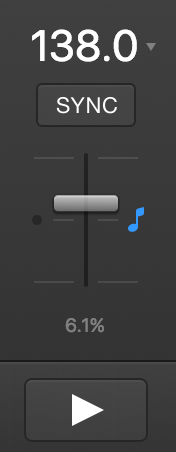
Note that in most software, altering the BPM will by default also alter the pitch of the song ? you don?t want this to happen so that you can accurately keep track of the song?s key. Most mixing software will allow you to disable pitch-bending on BPM change. In Djay Pro, this is done by clicking on the musical note next to the tempo slider.
5) Introduction to Harmonic Mixing
Harmonic mixing is the idea that certain song keys sound better (?harmonic?) together than others. A key tool to guide you in this process is the Circle of Fifths. At a most basic level, adjacent keys work well together.
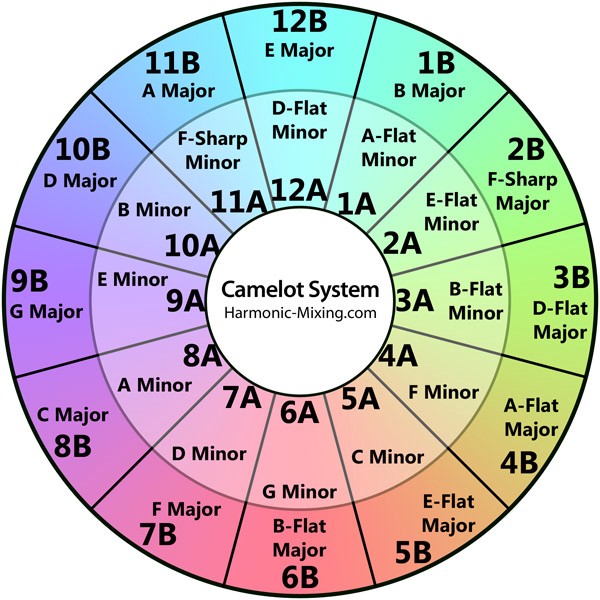 Circle of Fifths with Camelot Notation
Circle of Fifths with Camelot Notation
I cannot do any more justice to this topic than this (incredibly amazing) resource by MixedinKey ? this is where I?ve learned everything to do with harmonic mixing.
However, I will point your attention to the fact that if you sort by ?Key? in Djay Pro, songs are grouped by key and adjacent keys are also adjacent in the circle of fifths. So, all songs in C-major will appear next to a group of all songs in G-major.
Knowing this, given a song in any key, you have 2 keys you can transition to (in the most basic case, in reality, as the Harmonic Mixing guide will outline, there are many many harmonic mixing rules). In either of these keys, you can pick out a song with similar BPM. This is likely a good candidate for a song that will mix well into what you are playing.
At this point it becomes important to note that Djay Pro does not distinguish between major and minor keys out of the box. It took me a very very long time to discover this (it took me three months, in fact, at which point I saw this functionality on my boss?s laptop ? a week before my first live set). In order to see all songs broken into major and minor keys, in Djay Pro, go to Preferences > Media Library > Key > Distinguish Major / Minor Keys.
 Distinguish major/minor keys in Djay Pro
Distinguish major/minor keys in Djay Pro
6) Song Blending Techniques
There are numerous song-blending techniques which can be overwhelming if you try to digest them all at once. However, the more you get under your belt, the more flexibility you have in creating an effective mix between songs or genres. Written explanations would not do them justice, so I will point you to a two tutorials that outline the basic techniques.
5 Basic DJ Transitions Between 2 Songs
Mix Smoothly Between Different Tempos: 5 Creative DJ Techniques
When you?re introducing a new song, you should either be filtering the new song out, or removing one of the songs? bass until you?ve completed the transition. Both of these techniques help make the transition less jarring.
7) Finding Music
As I mentioned earlier, one of the major reasons I chose to use Djay was because of its Spotify integration. Djay also has a feature that helps you find songs that may blend with what you are playing:
 Finding music by BPM in Djay Pro
Finding music by BPM in Djay Pro
However, so far it currently only matches by BPM (not keys ? which I would personally find more useful). It also doesn?t let you play off Spotify when you?re offline, nor record with it.
When I started DJing, I started listening to everything I could possibly find in Spotify, including a wide variety of genres ? I found that mixing genres created an extremely lively dance floor and gives it depth. Then, after trying out blending them, I would go and download them from iTunes. Yes, on iTunes. Who still buys music anymore? DJs. DJs do. It?s because now you?re a musical artist and care about the people who make the music that you love to groove to, but also because you want the highest quality tracks.
Advanced reading about audio encoding: Bitrate detection through frequency spectrum analysis, Checking the true bitrate of audio files
However, you will be surprised by how much music you can find on Soundcloud ? a lot of artists give you the option to download a song for free/in exchange for following them on Soundcloud. If you find yourself using a software like Traktor, you can download the sounds in a low bitrate locally and experiment with it before downloading the high quality song at a later point.
8) Selecting a Hardware Controller
WOW, we?ve gotten so far and the only investment we?ve made has been some software. While you could (and should) definitely use a hardware controller for better mixing control, I would recommend only getting one at the point where you have learned the functionality of many features on screen. I personally did not buy my hardware controller until I tried to physically reach into my computer to adjust the nob of the song I was playing. I can?t undermine the power of hardware controllers; the difference they make is colossal. But if you?re a poor student like me, you generally want to put off investing in things you may or may not need and in hobbies that may or may not take off. That said, now that we?ve made it this far, you?re obviously interested and I?m obviously here to help.
Unless you are long-term stationary (I was not ? I?m moving every 4 months), you will want to look for a light controller with an audio card. No audio card means that your hardware controller needs to be connected to an amplifier. This is fantastic for audio quality and as a general idea, but was simply impractical for me. It would mean that I would have to buy (and move with) an amplifier and speakers. I also really cared about the portability of my controller because I would need to put it into my suitcase every four months, and this suitcase has a max weight of 50lbs. I could not afford a 12lb controller to steal this weight and and space when I am already moving my whole life from one country to another.
The Numark Mixtrack Pro 3 hardware controller (with built in sound card) was by FAR the best (entry level) controller I found. Coming in at 4lbs with metal jog wheels, all the EQ, filter, loop and cue functionalities, this was everything a beginner could dream of. The most important part was that Djay Pro had MIDI mapping for this controller out of the box. This meant that (almost) all the features I had in my software would seamlessly work on my hardware controller. Not all hardware and software is seamlessly compatible, so it is important to check the software?s documentation or search in its online community.
Overall, Amazon was an indispensable resource in the process. It included specification breakdowns, comparisons and related products that I may not have otherwise considered. Details about inputs, outputs, weight, size extremely useful at this point. Djay has a list of 50 natively supported hardware controllers on their site which can help get you started when you don?t know what to search for. Keep in mind that a lot of hardware you buy can come bundled with a trial of software it is compatible with, or sometimes the full version. The Numark controller was bundled with a trial of Serato, though I only ever used it with Djay.
When buying a controller, keep in mind that you may need a set of speakers at home to play around with pre-cueing / master output. Pre-cueing is used to listen to what you are about to play for the audience, while master is what everyone hears. Most DJ controllers have an RCA output which may not be the output you have for your portable speaker (but is standard output for DJ venues). To work around this, I bought myself an RCA-AUX adapter and a small portable speaker to listen to master output. However, I later realized that Djay could use built-in output (my laptop?s speakers) as the master output, even with the controller connected. Had I known this beforehand, I probably wouldn?t have bought the external speaker and RCA cable (given my semi-nomadic situation). If you have a more permanent set up, I would definitely recommend investing in a good set of speakers to hear your craft.
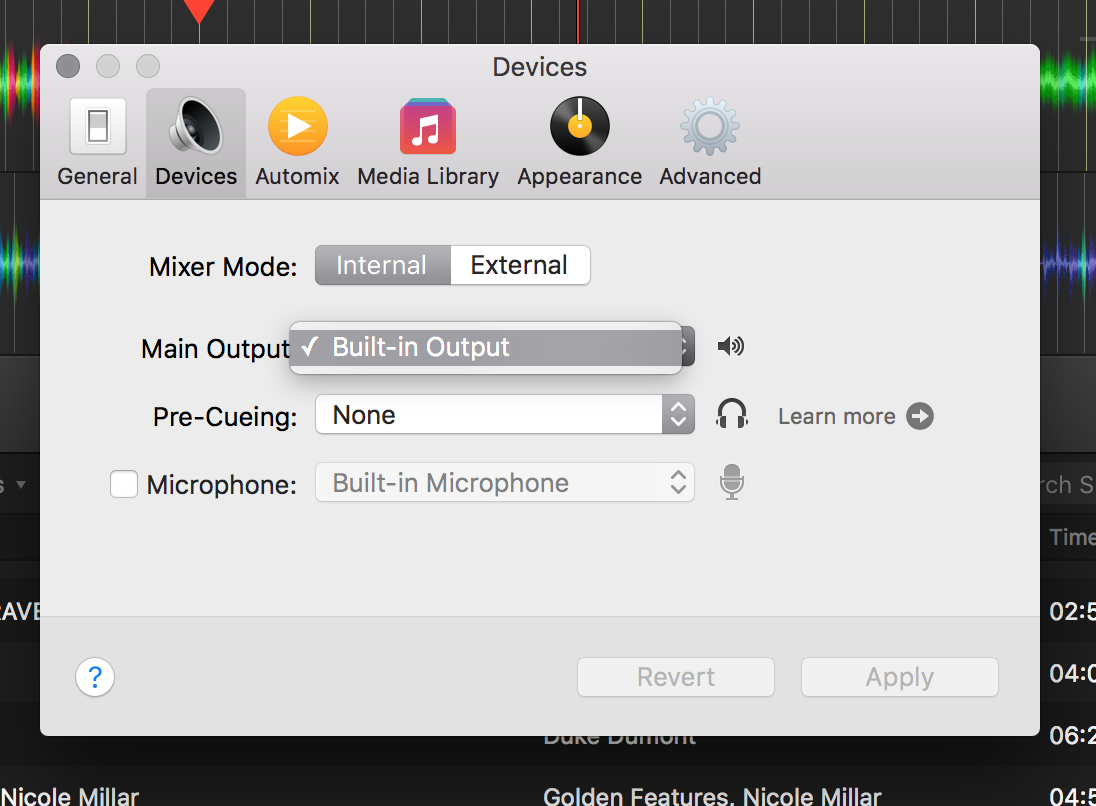 Using built in output in Djay Pro
Using built in output in Djay Pro
9) People
Granted, this is a pretty broad topic, but I wanted to talk about the importance of people in this whole process.
I always enjoyed music a lot. Music is cathartic. As I grew up, I did piano, dance, choir, music theory and made movies. DJing would have seemed like a natural progression for a music fanatic, but it eluded me for the longest time. It wasn?t until I had encountered a DJ with a powerful, optimistic, sharp and witty personality did I start to think that I could be a DJ myself. Now, being part of the tech industry, the importance of mentors and role models is very well-discussed. However, somehow its importance in other fields was overlooked. I was empowered by Alison Wonderland – after seeing her play, I began to genuinely consider that DJing could be something for me. In music, almost more than any other industry, you would think that diversity is a prerequisite given that everyone of all genders, races, ages, listens to music. However, finding people that you resonate with can be hard in reality. Having role models that inspire you can be a strong driving force.
I?ve looked long and far for more DJs with an open, engaged, mellow online presence but I haven?t found many. Some are inactive or, worse, have a snobbish demeanour. I find it also tends to propagate their stage presence, and I?m not really interested in taking example from that.
In terms of ?key opinion leaders? in the EDM/trap space, I love to follow: Mixmag, Boiler Room, Night Owl Radio. Alison Wonderland, Lido have a great online presence. I also love keeping up with Dopey (very talented vinyl DJ based in Toronto).
To learn something alone with the help of the internet, you have to know what you don?t know. But usually you don?t know what you don?t know. Consequently, having supportive people in person is indispensable. I owe a big thank you to Nikhil and Cristian for that day I showed up to their DJ club. I had been poking around in Ableton Live for 3 months with (still) no idea how to mix ? they told me I should use mixing (not production) software and taught me how to use a controller. 5 months later, Nikhil came out to my first DJ set in San Francisco. It was crazy to realize that if it weren?t for that day, I probably might have abandoned mixing because I didn?t know what to do next.
I also owe a big thank you to my manager, Jeff. He, out of the blue, without having ever heard me play before, knowing that I had never DJ?d live, took a leap of faith and included me in DOLOFEST and gave me a chance to play live. He could have easily said that I?m not experienced enough, or that I needed to have more tracks on Soundcloud, but he didn?t. The day he invited me to DJ I had the biggest smile on my face about getting my first gig.
In preparation, we went to sound check, where I learned how all the audio outputs worked, what it?s like to stand on stage, and most surprisingly, what it?s like to hear my own music on enormous speakers. He also spent an evening schooling me in DJing. He showed me that I could alter the BPM of a song without altering the pitch, how to move forward and backward in songs by measure, techniques of filtering out / cutting bass on transition, and how to use cue points to create flawless mixes. These had all been critical holes in my understanding of DJing. Sometimes, you have to see another person work to realize what you can do.
Lastly, sometimes you also have to ignore people. A lot of people will be really really supportive of you. But what?s harder to catch is the people who might not wholeheartedly support you. A powerful quote by Mark Twain comes to mind, one that is applicable whenever you are learning something new:
Keep away from people who try to belittle your ambitions. Small people always do that, but really great people make you feel that you, too, can become great.
You?ve got this. Now get off the internet and start mixing.
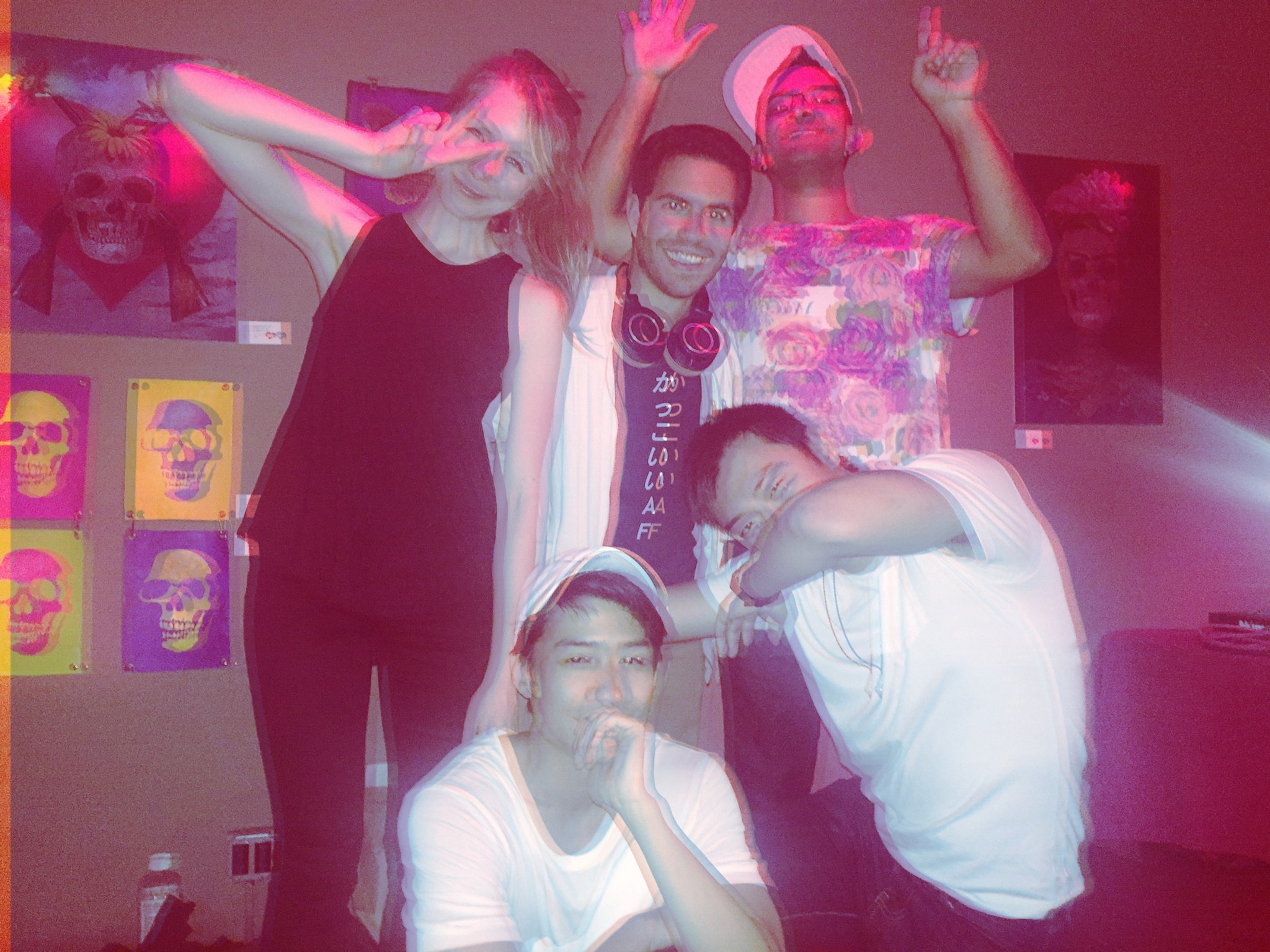 After DOLOFEST 2016
After DOLOFEST 2016
